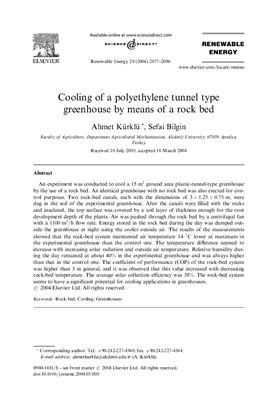На английском языке. Статья опубликована в ж. Renewable Energy. –
2004. –29(13). – P. 2077–2086.
Abstract
An experiment was conducted to cool a 15 m2 ground area plastic-tunnel-type greenhouse by the use of a rock bed. An identical greenhouse with no rock bed was also erected for control purposes. Two rock-bed canals, each with the dimensions of3 1:25 0:75 m, were dug in the soil of the experimental greenhouse. After the canals were filled with the rocks and insulated, the top surface was covered by a soil layer of thickness enough for the root development depth of the plants. Air was pushed through the rock bed by a centrifugal fan with a 1100 m3/h flow rate. Energy stored in the rock bed during the day was dumped outside the greenhouse at night using the cooler outside air. The results of the measurements showed that the rock-bed system maintained air temperature 14 °C lower at maximum in the experimental greenhouse than the control one. The temperature difference seemed to increase with increasing solar radiation and outside air temperature. Relative humidity during the day remained at about 40% in the experimental greenhouse and was always higher than that in the control one. The coefficient of perf ormance (COP) of the rock-bed system was higher than 3 in general, and it was observed that this value increased with decreasing rock-bed temperature. The average solar collection efficiency was 38%. The rock-bed system seems to have a significant potential for cooling applications in greenhouses.
Abstract
An experiment was conducted to cool a 15 m2 ground area plastic-tunnel-type greenhouse by the use of a rock bed. An identical greenhouse with no rock bed was also erected for control purposes. Two rock-bed canals, each with the dimensions of3 1:25 0:75 m, were dug in the soil of the experimental greenhouse. After the canals were filled with the rocks and insulated, the top surface was covered by a soil layer of thickness enough for the root development depth of the plants. Air was pushed through the rock bed by a centrifugal fan with a 1100 m3/h flow rate. Energy stored in the rock bed during the day was dumped outside the greenhouse at night using the cooler outside air. The results of the measurements showed that the rock-bed system maintained air temperature 14 °C lower at maximum in the experimental greenhouse than the control one. The temperature difference seemed to increase with increasing solar radiation and outside air temperature. Relative humidity during the day remained at about 40% in the experimental greenhouse and was always higher than that in the control one. The coefficient of perf ormance (COP) of the rock-bed system was higher than 3 in general, and it was observed that this value increased with decreasing rock-bed temperature. The average solar collection efficiency was 38%. The rock-bed system seems to have a significant potential for cooling applications in greenhouses.

